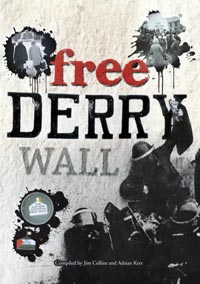21 January 2010 Edition
The world's most famous gable end

‘Free Derry Wall’
Compiled By
Jim Collins and
Adrian Kerr
Published By
Guildhall Press and
The Museum
of Free Derry
Price £12.95
REVIEWED BY PEADAR WHELAN
NUMBER 33 Leckey Road was just an ordinary house in the middle of the nationalist Bogside area of Derry. And were it not for the maelstrom of political conflict that convulsed the streets of the North of Ireland from 1968 onwards, it would have gone the way of all the other houses in the old Bogside of that time. It would have been ‘tumbled’, as we say in Derry, and replaced with a more modern slum.
Instead, the six words “You Are Now Entering Free Derry”, daubed on its gable wall in January 1969, made it famous worldwide and launched 33 Leckey Road onto the centre-stage of a conflict that raged for over 30 years and has yet to be politically resolved.
‘Free Derry Wall’, published at the end of 2009, is a history of the wall or, more accurately, the book chronicles the way Free Derry Wall has been enlisted in support of the many causes that are part of the political culture of the people of Derry.
SYMBOL OF RESISTANCE
This use of the wall to support the oppressed, at home and abroad lies in the way that the wall has become a symbol of resistance and hope for people the world over.
It stands proud among the many totems of defiance that have motivated thousands of people and a myriad of causes the world over.
These varied causes are celebrated in the book’s impressive assembly of photographs.
In the international arena, the cause of Palestine is supported, as is that of the Basque people.
This support is demonstrated by activists changing the artwork on the wall to portray their message of solidarity, which was well demonstrated last year when Zionist jets were depicted targeting Palestinian children during the Israeli Army’s bloody 14-day invasion of Gaza. Up to 400 children were slaughtered during that fortnight.
Sadly, Derry, for all its progressive politics and forward-looking community activists, earned itself a number of years ago the newspaper title of ‘Hate Capital of Ireland’ from the high number of homophobic attacks that occurred in the city.
Indeed, the 2000 Gay Pride mural on the back of the wall was the first ever to be vandalised.
WHAT IT MEANS
The authors also attempt to answer the question as to what Free Derry Wall means.
From the responses from people from all walks of life, most see Free Derry Wall as a symbol of resistance, of hope, of courage, of strength.
They liken it to a representation of the aspirations of people who have decided that they are no longer willing to bow to injustice, inequality or oppression.
Or, as former London Mayor Ken Livingstone put it: “The site will remain a symbol of the struggle for freedom.”
The one discordant note came from DUP politician Gregory Campbell. In his response to the authors he maintained: “It’s a reminder of all that was wrong.”
And for Gregory what was wrong was the rioting and people resisting the B-Specials and RUC rather than the 50 years of the unionist misrule and failure of Stormont politics that brought us into conflict.
Someone once posed the question: ‘If stones could speak, what would they say?’
Were that question directed at Free Derry Wall then surely the answer would be a very long one retelling the story of a people who decided that enough was enough and they would tolerate intolerance no more.
And that story would be a parable to the rest of the oppressed world.
• ‘Free Derry Wall’ is available from all good bookshops and the Museum of Free Derry. Phone Guildhall Press 028 71 364413 or online www.ghpress.com or the Mueseum of Free Derry www.museumoffreederry.org

